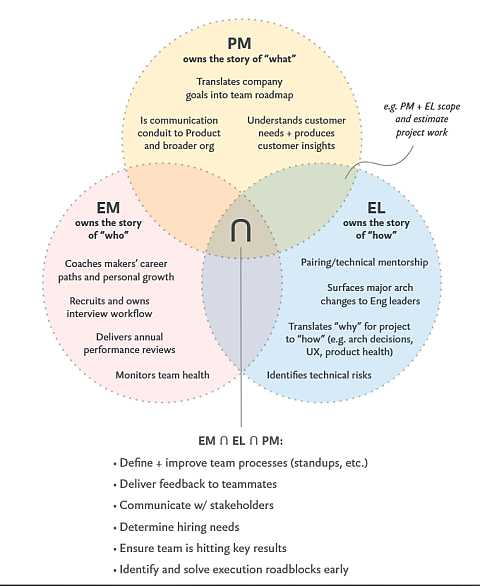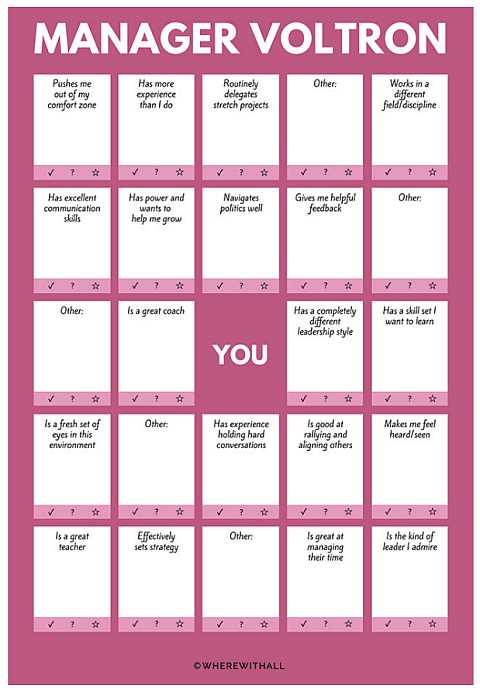# Introduction
- Human interaction in a corporate environment focuses on the team.
- There are lots of variations on "the team": shared skills, manager, functional area, or discipline.
- Team structure can get complex over time, with changing priorities, managers and focus areas.
- Teams are the atomic units of any organization, and regardless of how they are organized, the manager's job is to assess and improve team dynamics: the individuals forming the team, operations & strategy, diagnosing friction and clarifying ambiguity.
# Stages of Group Development
- Storming working through friction and confusion to define team characteristics.
- Norming resolving individual differences, introduce clarity and finding your groove.
- Performing in the flow state of effective work, with strong communication and shipping code.
Stages repeat throughout the lifecycle of a team, as new people join, managers change and the team's mission changes.
# Meet Your Team
# Core Needs
Humans have six core needs in the workplace:
- B elonging
- I mprovement/Progress
- C hoice
- E quality/Fairness
- P redictability
- S ignificance
# Belonging
- Connection with a community or group of people.
- Social rejection is interpreted as a threat.
# Improvement/Progress
- Sense of making progress.
- Learning powers growth.
- Challenge leads to career progression.
- The switch from maker (IC) path to management requires a recalibration of what success and productivity look like.
# Choice
- Autonomy
- Power to make decisions about work (and life).
- Balance between an overwhelming number of choices and none.
# Equality/Fairness
- Your environment includes equal access to resources, information, and support for everyone in it.
- Decisions are fair and communicated
# Predictability
- Need to make progress with change, but not be under constant change (which is exhausting).
- Balance between consistency and unpredictability.
# Significance
- Understanding of where we sit in a hierarchy, relative to others.
- Value contribution to larger organization.
- Visibility to self and others.
- Encompasses title, role and responsibilities.
Each person might care about a specific core need differently than others, and this can also change over time.
Understand each team member's growth areas, feedback preferences and how they like to be recognized.
# Help the Team Get To Know You
Understand and communicate your distinct approach to work and communication.
When managers share their approach to management with their teammates, it can create an opportunity to develop better working relationships.
# What Are You Optimizing For?
Start by thinking about scenarios in your work:
- coaching, mentoring, or sponsoring
- requesting and delivering feedback
- goal setting or vision setting for/with your team
- scoping, delegating, and shipping work for/with your team
- communicating to/with your teammates in different mediums
As a manager where do you focus? What value systems emerge?

# Coaching Questions
- Which core BICEPS need comes up the most often for you?
- What are your work styles and preferences? What are your own answers to the “First 1:1 Questions”?
- What do you wish you could optimize for in the day-to-day of your manager role?
- What kinds of introspection have you avoided doing with your teammates so far? Why?
- As you introspect about your own needs, preferences, and optimizations, what new realizations could you share with your manager in your next 1:1?
# Grow Your Teammates
As teams learn how to work together and grow, and respond to external influences and changes they can experience friction and challenges.
There are four general activities that help the team gel and improve.
# Mentoring
Lending advice and helping to problem solve based on your own experience.
Mentoring is probably over-represented in most managers' toolboxes.
It can feel good and be very effective in avoiding major errors, but personal experiences and advice can become dated and lack appropriate context.
Differences between mentors and mentees in gender or other groups can make advice for one person inappropriate for another.
Mentoring limits the developing team member from connecting the dots themselves.
# Coaching
Asking open questions to help your teammate reflect and introspect, rather than sharing your own opinions or quickly problem solving.
- Ask open-ended questions. Help the other person explore the shape of the topic, vs staying on the surface.
Closed questions: can be answered with yes or no.
Open questions: often start with who, what, when, where, why and how.
Why often feels confrontational or judging.
How encourages you to jump into problem solving.
Typically in Coaching you want to avoid both of these, but What questions are authentically curious.
- Reflect. Hold up a mirror for the other person and describe what you see and hear. Ask them to reflect for themselves.
Help explore the topic more deeply.
Involves active listening and mirroring.
Look for confirmation by rephrasing: "What I hear is your frustration with how the slowly project is progressing; is that right?"
Make statements about your interpretation. "My take-away is that you deeply care about your co-workers and want to help them do their best work."
If you get the reflection wrong it could indicate the other person is struggling to understand the topic, or there's more to explore.
reflection => introspection
When coaching you don't need to have all the answers; you're a mirror and a question-asker.
Coaching generates long-term, self-sufficient growth.
Very effective with new leaders who you want to develop their own path through deep thought and introspection.
# Sponsoring
Finding opportunities for your teammate to level up, take on new leadership roles, and get promoted.
Mentoring and Coaching: actively with the target-individual.
Sponsoring: when they're not around: a 1:1 with your manager, another meeting, learning about a new project, planning an All-Hands meeting.
Being on the hook for getting someone to the next level.
Different opportunities to sponsor:
- visible or public recognition.
- presentations or demos.
- cross-team feedback.
- assigning stretch tasks and projects.
- opportunities to reach beyond their current team, or the organization, like presenting at a conference or contributing to open-source work.
Members of underrepresented groups are typically over-mentored, but under-sponsored.
# The Feedback Equation
Observing behavior that is or isn’t aligned to what the team needs to be doing and sharing those observations, along with praise or suggestions.
The best feedback is specific, actionable, and delivered in a way that ensures the receiver can actually absorb it.
# Observation
Start with a statement of your observations of someone’s behavior.
Keep it simple and factual: who, what, when and where.
# Impact
Describe the impact. This should include how you feel.
Try to paint an objective picture of the effects of the behaviour.
If measurable, include this. If not, dig into the impact, asking "but what's the impact of that?"
Focus on a single issue that's important to the individual. Framing feedback in terms the recipient cares about will motivate corrections.
The goal is to move the recipient into problem-solving mode.
# Request or Question
Avoid giving advice or making a request at this point.
Coach over Mentor: ask an open question to encourage reflection.
# Coaching Team Members to Deliver Feedback
Workshop delivering feedback, with practice sessions.
Start with Coaching, reflective questions that help them drill into the impact.
Mentor with the Feedback Equation.
If there's nothing actionable, there isn't feedback; coach the person who wants to give the feedback to introspect and look for a different perspective.
If you need to deliver 3rd party feedback, try to find part of it to own directly.
# Balancing Act
Too often we use mentoring, but the balance of mentoring, coaching, sponsoring, and feedback is key to:
- Build Trust
- Gain Shared Context
- Plan and Support Career Growth
- Solve Problems
# Set Clear Expectations
Working through the norming stage into performing requires a shared set of expectations - what normal is.
- Teammate roles (including the manager)
- Team vision and priorities
- How teammates should be collaborating, communicating and shipping work.
Work to set these collaboratively, giving the team opportunities to shape their environment.
Clarity will help meet the team's needs for Belonging, Equality and Fairness.
- Responsibility assignment matrix (RACI) defines roles for people involved in a project or decision.
- Responsible: Person or people who do the work
- Accountable: Person who ensures the project is completed or the decision made
- Consulted: Small group who influence work in progress. Get a say but don't do the work.
- Informed: Updated on milestones or delivery.
# Venn Diagram

- Capture all team meetings' purpose, frequency and participants. This helps team members determine if they should attend, would like to attend or are safe to skip.
- Set team expectations around work hours, on-call situations and emergencies.
- Document your team’s messaging channels, email lists, and resource pages.
- Set expectations for collaboration, like pairing, Jira tickets, communication in different scenarios
Setting expectations will build a solid foundation upon which your team grows and evolves.
# Communicate Effectively
Managers need to communicate as the organization and environment continues to change around them.
Often you'll need to do this without having a say in the strategic decision that you know need to share and help your team understand.
Front line leaders are in the best position to do this!
- You know the individual
- You know what they and the team need
- You have insight into how they will interpret the news and react.
- You can give feedback to the architects of the change to help sculpt their message so it will be heard and understood.
# Communications Plan
- Avoid being to opaque or convoluted.
- Have answers for obvious and predictable questions.
- Help soothe core needs when you share sensitive information with the team.
Header: author, date, status (e.g. draft)
Background:
- the What (most important thing you want to communicate)
- the Why (why’s it changing)
People:
- who knows
- who will be directly impacted
Timeline:
- what will be said in [IRL or channel] when
Talking points:
- Communications plans for sensitive information should be executed as swiftly as possible.
- Map big changes back to the things you know people care about and make notes in your talking points.
- Choose your planned words carefully. What extra information should be shared? In which medium(s)? What should you not say to deescalate fears?
- Plan out who can be informed early/later, and sequence order of operations.
- Optimize for creating clarity and transparency as soon as decisions have been made.
- Add extra interim steps to deal with specific cases (ex: a team particularly hit hard in similar past situations).
# Sharing Misaligned Information
Sometimes you have to communication information that you don’t agree with or believe in.
- Be transparent and professional with higher-up's decision.
- Ask a lot of questions
- Share potential negative impact.
- Give feedback.
Decision Time: disagree and leave (team or company) -OR- disagree and commit.
- Add steps in your communications plan explicitly designed to collect feedback.
# Communications Mediums
- Meetings: most cannot be emails because the context and nuance is lost.
- All Hands: roll out big news all at once.
- Emails: status and announcements without a lot of nuance or tone.
- Recap Email: repeat decisions after the meeting, with extra details and references.
# Build Resiliency
Team development is an exhausting cycle. Even after the storming and forming states, you can be pulled out of performing by changes external to the team.
Change is a continuous. Managers need to build resiliency and experience, new tactics and skills to manage inevitable waves of change.
# Before the Crisis
- Know your benefits. Educate your team about what resources are available - before they are needed.
- Lead by example. Show it's OK to take a day off for mental health reasons, or visit the doctor, or to take care of yourself.
- Ask for input. Gather feedback about team processes, what information and resources they need, and secure them for the team.
- Keep setting expectations. Leverage the team norms and shared values, give clarity and anchor on the team for stability.
# During the Crisis
- Mirror your understanding to show empathy; don't impose your own need on the individual(s).
- Offer obvious help, or ask how you can help.
- Track your energy levels; identify activities or events where you use and recharge.
- Color-code your calendar to correlate activities with their impact, including scheduling, time of day and context switching.
- Reprioritize:
- Important and Urgent: Do it now
- Important but not Urgent: Schedule for later
- Not important but Urgent: Delegate
- Not important and not Urgent: Eliminate
# Reasons (Excuses) Why You Can't Delegate
- Team issues - don't want to add to them.
- Just need to get organized to give direction & support.
- This is my job; it's not fair to delegate.
The best gift you can give your teammates is a messy, hard-to-measure, unscoped project.
This kind of project creates the biggest opportunity for someone to grow as a leader.
- Tell them how and in what medium you will support them.
- Use a RACI to help in understanding and provide guidance.
- Say NO to new/more things.
# Building a Support Network
Build a team of diverse experts to backfill your inexperience and weaknesses.
# The Manager Voltron
A team of supportive workplace buddies.
- Push you out of your comfort zone
- Different levels of experience than you do (both more and less)
- Experience in a different industry
- Good at the things that you’re terrible at

Adding someone to your team:
- Choose a topic where you would genuinely like some help or a new perspective.
- Consider who in your extended network might have some experience or opinions on the topic.
- Reach out (via email, or another asynchronous medium) to that person to ask them if they’d like to discuss the topic.
Make it easy to Opt-in.
Your First Team is not the people who report to you, it's your peers across the company. They help with decisions that consider the entire company before focusing on the needs of an individual team.
# Conclusion
The general metaphor of a team being liked a caterpillar transforming into a butterfly focuses on the cocoon, a gap and then the emergence of a butterfly. This is both inaccurate and misrepresents the "sausage making" of how strong teams are created.
It's messy, hard work that yields incremental improvements through constant, iterative measurement, assessment and attention. There's challenging and even destructive change, struggle and pain. This is growth.
You've made it through a lot of difficult situations and need to continue to embrace these opportunities.
- Listen for changes in BICEPS needs.
- Assess what extra experience, advice or resources you need to move forward.
- Protect your energy.
- Look for people you can lean on: mentors, coaches, sponsors and supporters who can give you feedback.
